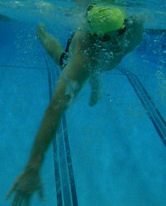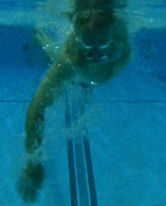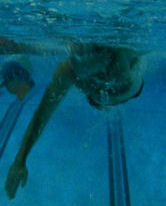Problem: Straight-Arm Stroking
Top row: Problem swimmer. Bottom row: US elite distance swimmer Erik
Vendt.
 |
 |
 |
|
Don
|
Kevin
|
Mike
|
 |
 |
 |
|
Erik Vendt: From start to end of stroke, his elbow is never very
far from the surface. He gets hold of the water very early in his
stroke with his hand and forearm, and pulls his body past that spot.
Looking at the video, I see his hand and forearm in many, many frames.
That means that he is holding a spot in the water while he moves
forward (towards the camera). In contrast, straight-arm swimmers
only shows their hand and arm for a few frames around the middle
of the storke.
|
When you are straight-arm stroking:
- On the first half of your stroke, you are pressing down on the water,
pushing your body up (not forward).
- When your arm gets vertical in the water, for that instant, you are
applying pressure in the right direction (perpendicular to your direction
of travel).
- On the second half of your stroke, you pushing up towards the surface,
pulling your body down in the water (not forward).
- You are making that large circular motion using your shoulder muscles.
|
|
Here is a sequence showing how an expert swimmer (Erik Vendt) looksfrom
the start of the catch to the end of the stroke:
His left elbow is never very far from the surface. Compared to the newer
swimmers, he spends way more of his time pulling his body forward, not
pushing it up or down in the water.
Other things to notice:
- His right hand is almost fully extended before he begins the pull
with his left hand.
- His eyes are looking straight down at the bottom of the pool - not
forward.
- His head is deep in the water.
- His kick is not extending very far out of the shadow of his body.
- His shoulders do not rotate very much (but on shots from the side
you will see that his hips rotate to almost 90°).
|

